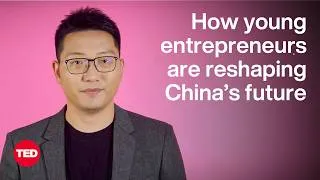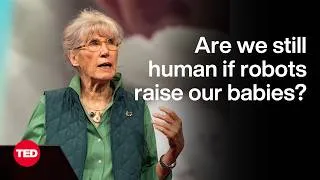Have we reached the limit of computer power? - Sajan Saini and George Zaidan
322,271 views ・ 2025-01-23
请双击下面的英文字幕来播放视频。
翻译人员: Yip Yan Yeung
校对人员: XU Gloria
00:06
In the Netherlands,
there’s an ambitious company
0
6919
2253
在荷兰,
有一家雄心勃勃的公司
00:09
that builds one of the most advanced
and expensive tools in the world:
1
9172
4087
正在制造世界上最先进、
最昂贵的工具之一:
00:13
a single unit costs hundreds
of millions of dollars.
2
13259
3253
每台成本高达数亿美元的计算机设备。
00:16
And when companies buy one,
3
16554
1376
如果有一家公司购买了一台设备,
00:17
they also need 250 engineers to install
the 165-ton device
4
17930
5798
还需要 250 名工程师来安装
这台重达 165 吨的设备,
00:23
in a process that typically
takes half a year.
5
23770
3211
通常耗时需要半年。
00:27
But despite this steep cost
in time and money,
6
27106
2711
但是,尽管要耗费大量时间和金钱,
00:29
many microchip makers desperately
want one of these machines.
7
29817
3879
许多微芯片制造商
还是迫切想要一台这样的机器。
00:33
The hundred-million-dollar question
is: why?
8
33863
3212
这价值上亿美元的问题是:为什么?
00:37
The answer has to do with something
called Moore’s Law.
9
37283
3378
答案与所谓的“摩尔定律”有关。
00:40
First coined by Intel co-founder
Gordon Moore,
10
40703
3379
该定律最初由英特尔联合创始人
戈登·摩尔提出,
00:44
this law states that every 1 to 2 years
11
44082
2544
指出每隔 1 至 2 年,
00:46
the number of transistors that can fit on
a given size computer chip will double.
12
46626
4671
一定尺寸的计算机芯片上
可以容纳的晶体管数量会翻倍。
00:51
And by extension, the rough number of
calculations that chip can do per second
13
51380
4630
推而广之,芯片每秒
能够进行的粗略计算量
00:56
will also double.
14
56010
1627
也将翻一番。
00:57
Now, this law isn't
a physical law like gravity.
15
57887
2920
这个定律不是像重力这样的物理定律。
01:00
It’s just a trend Moore observed
during the early 1960s.
16
60848
4004
它只是摩尔在 1960 年代初
观察到的一种趋势。
01:04
But chipmakers turned that trend
into a goal, and in turn,
17
64977
3671
但是芯片制造商将这种趋势
视作目标,于是反过来,
01:08
consumers learn to expect
computing progress to continue
18
68648
3462
消费者学会了期待计算
将持续以这种指数级的速度发展。
01:12
at this exponentially fast pace.
19
72110
2335
01:14
And the amazing thing is, for six decades,
it pretty much has.
20
74570
3754
令人惊奇的是,六十年来,
它差不多就是这么发展的。
01:18
Thanks to Moore’s Law, chips have
gotten smaller, faster,
21
78407
3504
由于摩尔定律,
芯片变得更小、更快、
01:21
more efficient, and cheaper.
22
81911
1960
更高效、更便宜。
01:23
But today, there are four key problems
that trip up this trend,
23
83955
3295
但是如今,有四个关键问题
阻碍了这一趋势,
01:27
potentially ending Moore’s Law
24
87333
1960
有可能会终结摩尔定律,
01:29
and fundamentally changing how
we make progress in computing.
25
89293
3671
彻底改变我们在计算领域
取得进展的方式。
01:33
The first is transistor size.
26
93172
2127
首先是晶体管的尺寸。
01:35
Transistors are basically on/off switches,
27
95341
2753
晶体管其实就是开关,
01:38
and these building blocks of digital
computing have been shrinking
28
98094
3837
自 1960 年代以来,
这个数字计算的构件一直在缩小。
01:41
since the 1960s.
29
101931
1752
01:43
But recently they’ve gotten so small,
30
103808
2336
但是最近它们变得如此之小,
01:46
quantum physics has begun to interfere
with their functions.
31
106144
3211
量子物理开始干扰它们的功能。
01:49
When a transistor’s switch, or gate,
is less than 20 nanometers,
32
109480
4004
当晶体管的开关或栅极
小于 20 纳米时,
01:53
electrons will tunnel
along it continuously,
33
113484
2753
电子将不断流过这个通道,
01:56
turning a crisp on/off switch
into a hazy dimmer.
34
116279
4170
将本该清晰开或关的开关
变成一个模糊的渐变开关。
02:00
The second problem is heat.
35
120700
1793
第二个问题是热量。
02:02
As chipmakers make components
smaller and more complex,
36
122493
3545
随着芯片制造商
制造的组件更小、更复杂,
02:06
the copper lines that run between them
need to be thinner and longer.
37
126038
3754
组件之间的铜线必须更细、更长。
02:09
This increases their electrical resistance
and generates high heat
38
129959
3837
这会增加电阻、产生高温,
02:13
that impairs chip performance
and can’t be easily dissipated.
39
133838
3879
从而损害芯片性能
且散热并不容易。
02:17
Today’s chips can already run
hot enough to cook an egg,
40
137884
3378
当今的芯片运行的温度
已经高到可以煎鸡蛋,
02:21
and temperatures are only predicted
to increase without new innovations.
41
141387
4797
如果没有更多创新,
预计温度只会继续升高。
02:26
While both these issues represent limits
in the fundamental physics of chipmaking,
42
146350
4213
尽管这两个问题都代表了
芯片制造在基础物理上的局限性,
02:30
researchers haven't stopped
trying to solve them.
43
150563
2377
但研究人员并没有停止
尝试解决这些问题。
02:33
Unfortunately, their solutions often
exacerbate the third major problem:
44
153191
4462
不幸的是,他们的解决方案
往往会加剧第三个主要问题:
02:37
chipmaking’s environmental impact.
45
157653
2419
芯片制造对环境的影响。
02:40
For example, swapping copper lines
for ruthenium
46
160239
3504
例如,将铜线换成钌
02:43
could help pack transistors more tightly
and keep chips smaller—
47
163743
4171
有助于更密集地封装晶体管,
让芯片更小,
02:47
but that metal is far scarcer than copper
48
167997
2711
但是这种金属比铜稀缺得多,
02:50
and would require new
mining infrastructure.
49
170750
2669
需要新的采矿基础设施。
02:53
Similarly, the technology currently used
to make today’s smallest transistors
50
173586
4338
同样,目前用于
制造当今最小晶体管的技术
02:57
requires huge amounts
of energy and chemicals
51
177924
3044
需要大量的能量和化学物质,
03:00
called perfluoroalkyl
and polyfluoroalkyl substances,
52
180968
5464
称为全氟烷基和多氟烷基物质,
03:06
which can take thousands of years
to break down in the environment.
53
186432
3670
这些物质可能需要数千年
才能在环境中降解。
03:10
Managing these first three problems
contributes to the final issue: cost.
54
190311
4588
要解决前三个问题
会导致最后一个问题:成本。
03:14
To keep achieving Moore’s Law,
55
194982
1961
为了继续实现摩尔定律,
03:16
chipmakers have to make individual
chip components smaller.
56
196943
3712
芯片制造商必须缩小每一个芯片组件。
03:20
And this is where that costly
$400 million machine comes in.
57
200780
4796
这就说到了那台
耗资 4 亿美元的天价机器。
03:25
This marvel of chip-making science shoots
a stream of tin droplets
58
205576
4463
这个芯片制造科学的奇迹
将一注锡滴
03:30
into a vacuum chamber before blasting them
with a high-energy laser
59
210039
4171
射入真空室,然后用高能激光
03:34
that vaporizes the tin to create plasma.
60
214210
3003
将其炸开,使锡蒸发,
产生等离子体。
03:37
In turn, the plasma emits a 13.5 nanometer
wavelength of ultraviolet light
61
217421
6340
等离子体转而发射
波长为 13.5 纳米的紫外线,
03:43
that can be used to produce
incredibly small transistors.
62
223803
3670
可用于生产非常小的晶体管。
03:47
This remarkable feat of engineering
has helped chipmakers
63
227473
3253
这一非凡的工程壮举
帮助芯片制造商
03:50
keep up with Moore’s Law.
64
230726
1835
跟上了摩尔定律。
03:52
But as chips keep getting denser,
65
232687
2294
但随着芯片的密度不断提高,
03:54
intricate manufacturing plants
keep getting more expensive.
66
234981
3545
精密的制造工厂越来越昂贵。
03:58
This trend has been so consistent,
it’s actually earned the nickname
67
238734
3837
这种趋势一直很稳定,甚至取得了
04:02
Moore’s Second Law.
68
242571
2086
“摩尔第二定律”的绰号。
04:04
Obviously, all these trajectories
are unsustainable.
69
244991
3378
显然,这些发展趋势
全都是不可持续的。
04:08
Manufacturing plants can’t
keep increasing in price,
70
248452
3003
制造工厂不能继续涨价,
04:11
our ecosystems can’t endure endless
mining and pollution,
71
251455
3796
我们的生态系统
无法承受无止境的采矿和污染,
04:15
and the laws of physics are unlikely
to change anytime soon.
72
255376
3587
物理定律不太可能在短期内改变。
04:19
Fortunately, Moore's Law is flexible,
73
259130
2502
幸运的是,摩尔定律很灵活,
04:21
and there’s no reason we can’t
introduce new goals
74
261757
2920
我们依然可以引入新的目标
来取得负责任的计算进步。
04:24
to keep making
computing progress responsibly.
75
264677
2961
04:27
Perhaps we could introduce
a new Sustainability Law?
76
267763
3629
也许我们可以提出
新的可持续发展定律?
04:31
Smaller transistors already use less
material and produce less e-waste,
77
271517
4880
更小的晶体管使用更少的材料,
产生更少的电子垃圾,
04:36
and advancements
in electronic-photonic integration
78
276480
3254
电子光子集成的进步
04:39
are allowing chips to use less energy
and generate less heat.
79
279734
3753
使芯片消耗更少的能量,
产生更少的热量。
04:43
So perhaps chips should be made twice
as sustainable every several years?
80
283571
4463
那么,也许芯片的可持续性
应该每隔几年翻一番呢?
04:48
Whatever the answer is,
81
288117
1960
不管答案是什么,
04:50
we make the laws,
so the future is up to us.
82
290119
4296
我们提出定律,
所以未来在我们手中。
New videos
Original video on YouTube.com
关于本网站
这个网站将向你介绍对学习英语有用的YouTube视频。你将看到来自世界各地的一流教师教授的英语课程。双击每个视频页面上显示的英文字幕,即可从那里播放视频。字幕会随着视频的播放而同步滚动。如果你有任何意见或要求,请使用此联系表与我们联系。







